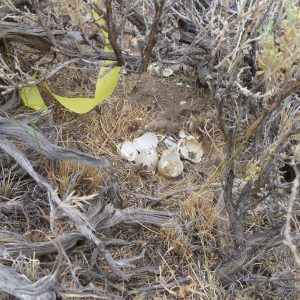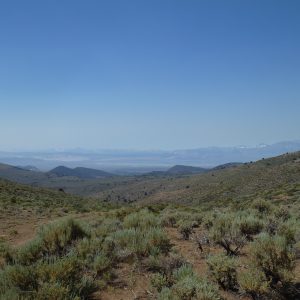Going from one of the muggier parts of the country to one of the driest has been one of the more dramatic transitions that I’ve experienced since starting my internship here at the Bishop BLM—not that I’ve had much time to process it. It’s hard to believe that I’ve already been here for three weeks…or is it hard to believe that it’s only been three weeks? Coming in at the height of field season has made for a hectic—and exciting—first month on the job, and I’ve been having a blast.
As someone who has spent most of her life within ten hours of the East Coast, shrub diversity was never something I paid much attention to (not with so many interesting trees overshadowing their diminutive counterparts). Here in the scrublands, however, shrubs rule supreme, and I have spent a lot of time these past few weeks learning to distinguish between bitterbrush and sagebrush, wax currants (Ribes cereum) and desert gooseberry (Ribes velutinum), horsebrushes and rabbitbrushes (not to mention rabbitbrushes and rabbitbrushes). Especially interesting is spiny hopsage (Grayia spinosa), a medium-sized shrub that is found throughout Eastern California. The showiest parts of the plant are not its flowers, but rather the seed-bearing bracts—small, colorful structures that look like a cross between a petal and a leaf. In the spring, the bracts are bright pink; as they dry, they turn yellow and crispy. And as the first plant that I collected seeds from for SOS, hopsage is definitely one of my favorite plants to run across in the field.
The most challenging shrub identification task we have to tackle on a regular basis is teasing apart the different sagebrushes. Distinguishing between low sagebrush (Artemisia arbuscula) and smaller big sagebrush individuals (Artemisia tridentata) can be tricky, but it gets especially complicated when you try to separate out the three subspecies of big sagebrush: big basin sagebrush, Wyoming big sagebrush, and mountain big sagebrush. And did I mention that they hybridize? But it turns out that these distinctions matter, and not just to someone interested in taxonomy. These subspecies are chemically distinct, and it makes a difference to the nesting sage grouse that use these shrubs as both shelter for their nests and a critical food source during nesting season. This is one of the coolest parts of my job—getting to work on a variety of projects, most of which depend on each other in some way and really get at the interactions between animal species of interest and the plant communities that they depend on.
Until next time!



